Abstract
According to the commonest definition, infant colic is distinguished by crying which is 'paroxysmal'-that is, intense and different in type from normal fussing and crying. To test this, maternal reports of the distress type of 67 infants whose fuss/crying usually exceeded three hours a day ('persistent criers') were scrutinised using 24 hour audiorecordings of the infants' distressed vocalisation. 'Moderate criers' (n = 55) and 'evening criers' (n = 38) were also assessed. Most of the distress in all three groups was fussing. In the audiorecordings the persistent criers showed a higher crying: fussing ratio than the moderate criers, but intense crying was rare. A third of the persistent criers were reported by their mothers to have occasional, distinct colic bouts of 'intense, unsoothable crying and other behaviour, perhaps due to stomach or bowel pain.' In the audiorecordings these periods were longer, but not paroxysmal in onset or more intense than the crying of persistent criers not judged to have colic. The audible features of the crying may be less important than its unpredictable, prolonged, hard to soothe, and unexplained nature.
Full text
PDF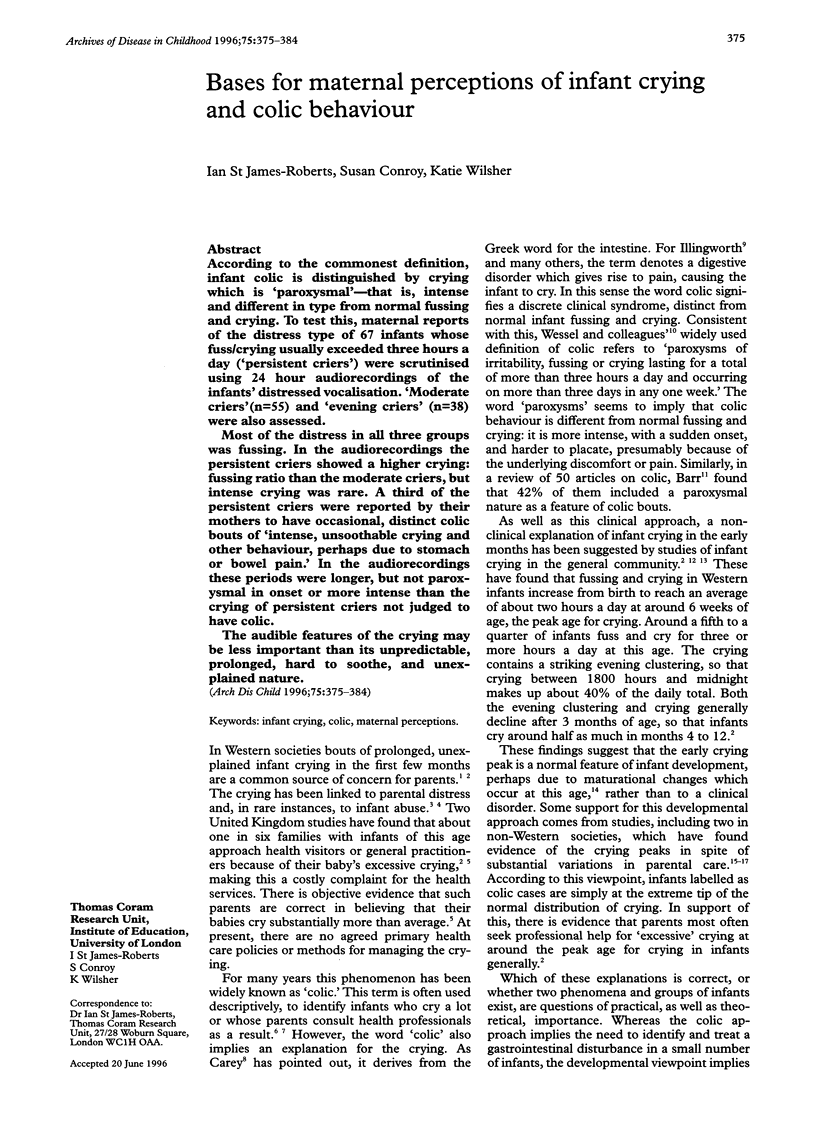

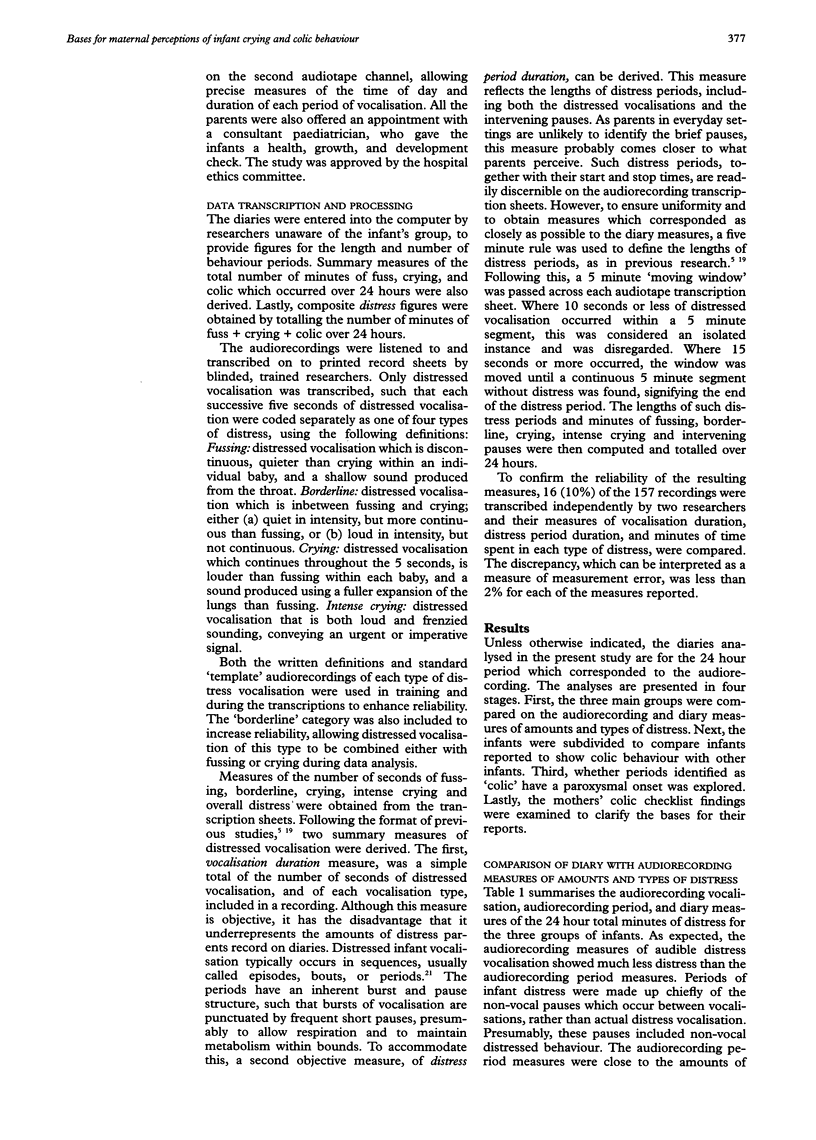
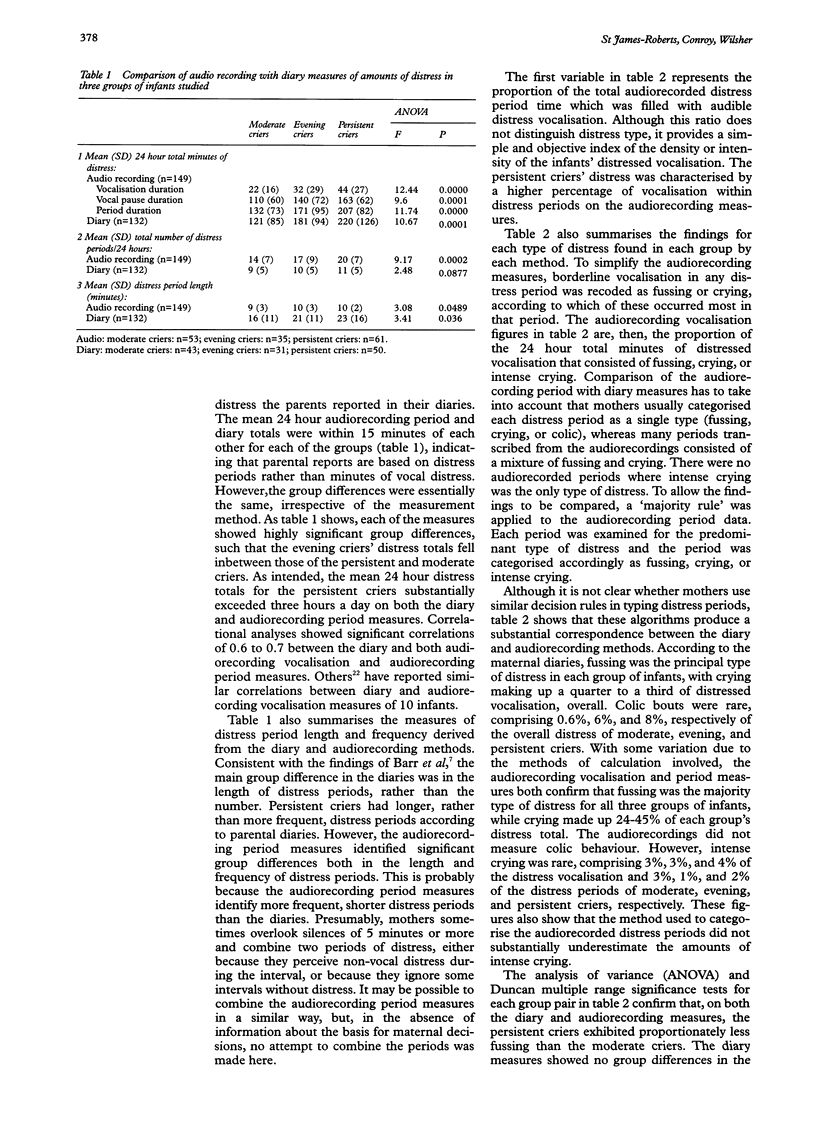
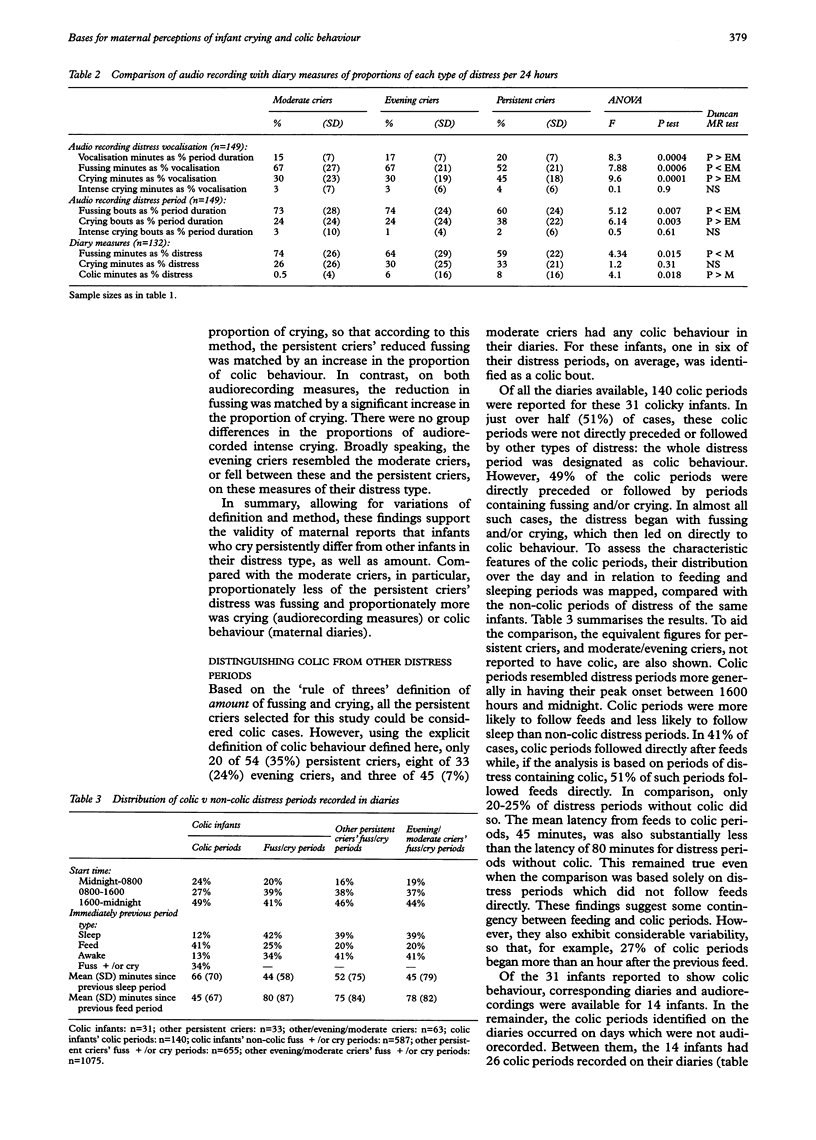
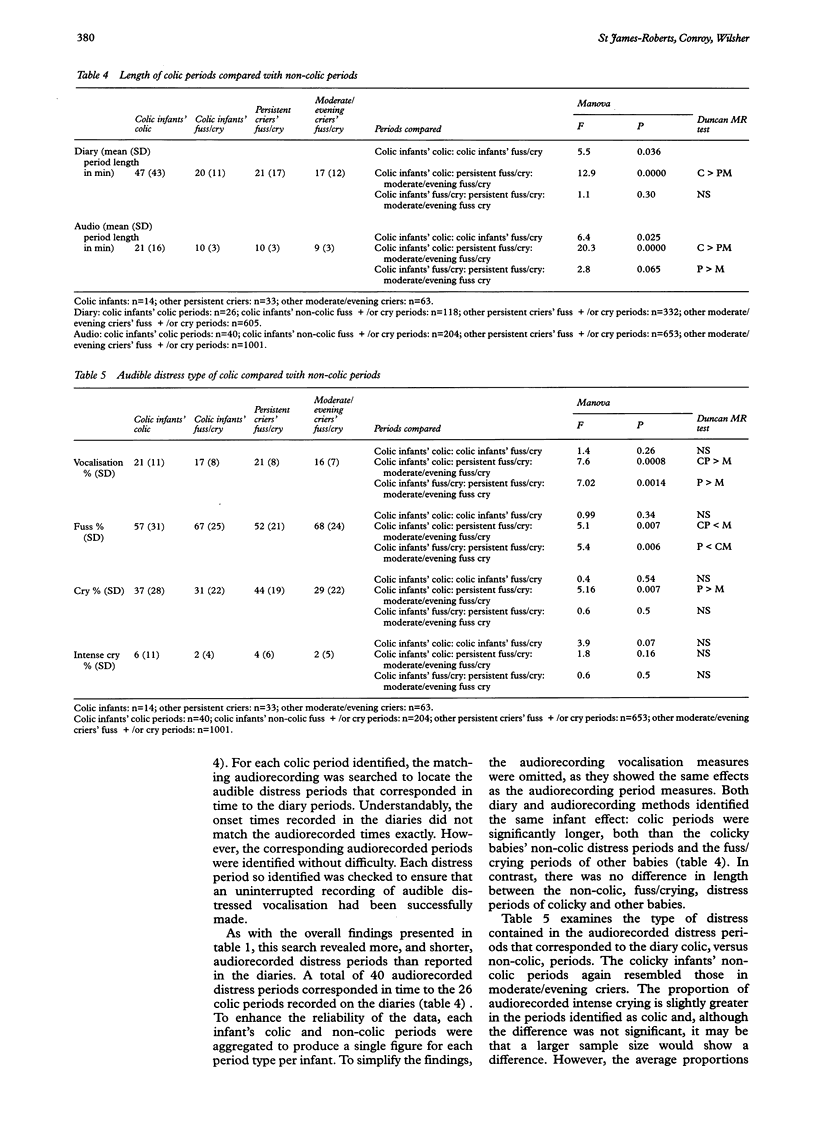

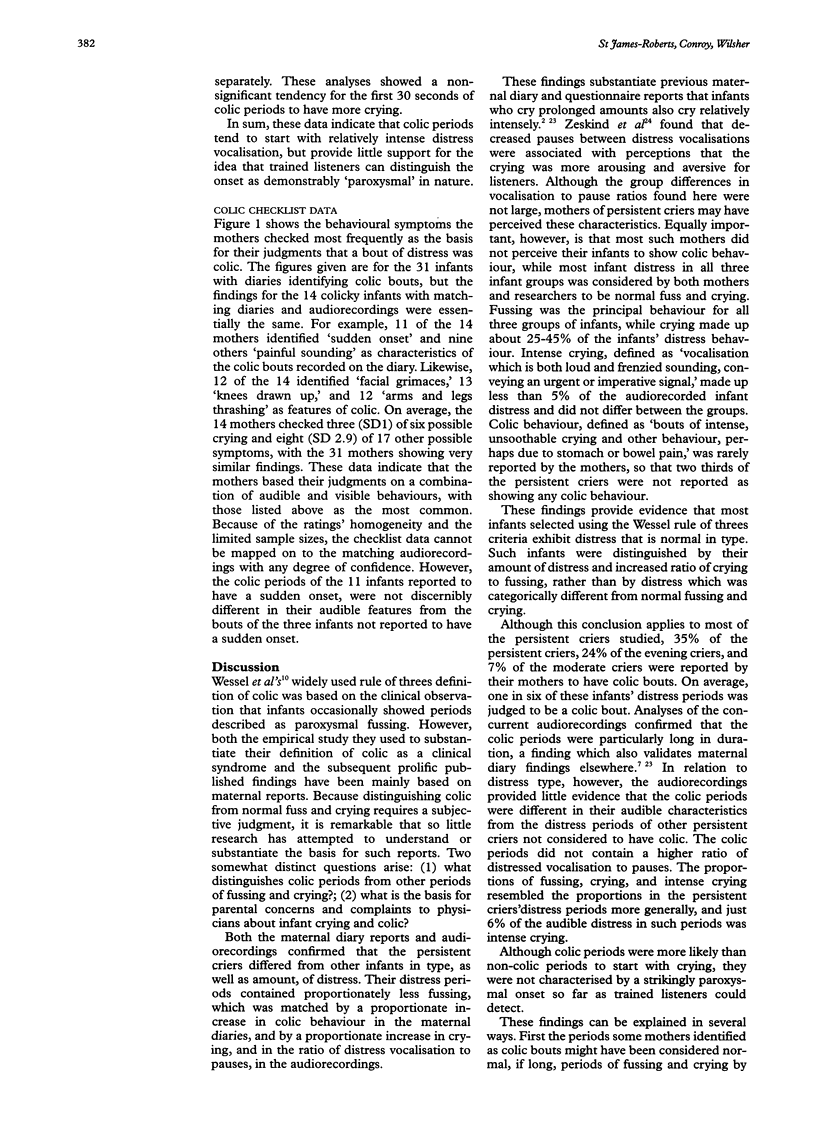
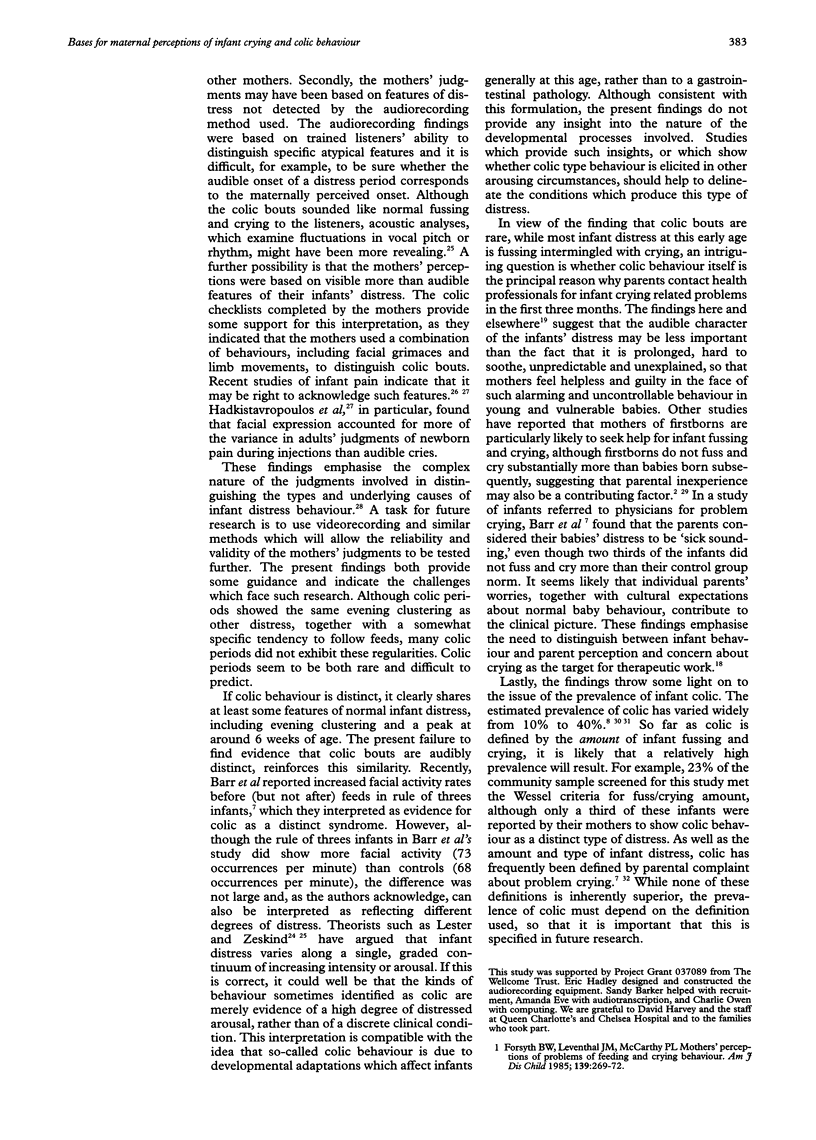

Selected References
These references are in PubMed. This may not be the complete list of references from this article.
- Alvarez M., St James-Roberts I. Infant fussing and crying patterns in the first year in an urban community in Denmark. Acta Paediatr. 1996 Apr;85(4):463–466. doi: 10.1111/j.1651-2227.1996.tb14062.x. [DOI] [PubMed] [Google Scholar]
- Barr R. G., Konner M., Bakeman R., Adamson L. Crying in !Kung San infants: a test of the cultural specificity hypothesis. Dev Med Child Neurol. 1991 Jul;33(7):601–610. doi: 10.1111/j.1469-8749.1991.tb14930.x. [DOI] [PubMed] [Google Scholar]
- Barr R. G., Kramer M. S., Boisjoly C., McVey-White L., Pless I. B. Parental diary of infant cry and fuss behaviour. Arch Dis Child. 1988 Apr;63(4):380–387. doi: 10.1136/adc.63.4.380. [DOI] [PMC free article] [PubMed] [Google Scholar]
- Barr R. G., Rotman A., Yaremko J., Leduc D., Francoeur T. E. The crying of infants with colic: a controlled empirical description. Pediatrics. 1992 Jul;90(1 Pt 1):14–21. [PubMed] [Google Scholar]
- Carey W. B. "Colic"--primary excessive crying as an infant-environment interaction. Pediatr Clin North Am. 1984 Oct;31(5):993–1005. doi: 10.1016/s0031-3955(16)34681-8. [DOI] [PubMed] [Google Scholar]
- Craig K. D., Hadjistavropoulos H. D., Grunau R. V., Whitfield M. F. A comparison of two measures of facial activity during pain in the newborn child. J Pediatr Psychol. 1994 Jun;19(3):305–318. doi: 10.1093/jpepsy/19.3.305. [DOI] [PubMed] [Google Scholar]
- Forsyth B. W., Leventhal J. M., McCarthy P. L. Mothers' perceptions of problems of feeding and crying behaviors. A prospective study. Am J Dis Child. 1985 Mar;139(3):269–272. doi: 10.1001/archpedi.1985.02140050063023. [DOI] [PubMed] [Google Scholar]
- Frodi A. M. Contribution of infant characteristics to child abuse. Am J Ment Defic. 1981 Jan;85(4):341–349. [PubMed] [Google Scholar]
- Hadjistavropoulos H. D., Craig K. D., Grunau R. V., Johnston C. C. Judging pain in newborns: facial and cry determinants. J Pediatr Psychol. 1994 Aug;19(4):485–491. doi: 10.1093/jpepsy/19.4.485. [DOI] [PubMed] [Google Scholar]
- Hunziker U. A., Barr R. G. Increased carrying reduces infant crying: a randomized controlled trial. Pediatrics. 1986 May;77(5):641–648. [PubMed] [Google Scholar]
- Illingworth R. S. Infantile colic revisited. Arch Dis Child. 1985 Oct;60(10):981–985. doi: 10.1136/adc.60.10.981. [DOI] [PMC free article] [PubMed] [Google Scholar]
- Michelsson K., Rinne A., Paajanen S. Crying, feeding and sleeping patterns in 1 to 12-month-old infants. Child Care Health Dev. 1990 Mar-Apr;16(2):99–111. doi: 10.1111/j.1365-2214.1990.tb00642.x. [DOI] [PubMed] [Google Scholar]
- Rautava P., Helenius H., Lehtonen L. Psychosocial predisposing factors for infantile colic. BMJ. 1993 Sep 4;307(6904):600–604. doi: 10.1136/bmj.307.6904.600. [DOI] [PMC free article] [PubMed] [Google Scholar]
- Rubin S. P., Prendergast M. Infantile colic: incidence and treatment in a Norfolk community. Child Care Health Dev. 1984 Jul-Aug;10(4):219–226. doi: 10.1111/j.1365-2214.1984.tb00181.x. [DOI] [PubMed] [Google Scholar]
- St James-Roberts I., Bowyer J., Varghese S., Sawdon J. Infant crying patterns in Manali and London. Child Care Health Dev. 1994 Sep-Oct;20(5):323–337. doi: 10.1111/j.1365-2214.1994.tb00394.x. [DOI] [PubMed] [Google Scholar]
- St James-Roberts I., Halil T. Infant crying patterns in the first year: normal community and clinical findings. J Child Psychol Psychiatry. 1991 Sep;32(6):951–968. doi: 10.1111/j.1469-7610.1991.tb01922.x. [DOI] [PubMed] [Google Scholar]
- St James-Roberts I., Hurry J., Bowyer J. Objective confirmation of crying durations in infants referred for excessive crying. Arch Dis Child. 1993 Jan;68(1):82–84. doi: 10.1136/adc.68.1.82. [DOI] [PMC free article] [PubMed] [Google Scholar]
- St James-Roberts I. Managing infants who cry persistently. BMJ. 1992 Apr 18;304(6833):997–998. doi: 10.1136/bmj.304.6833.997. [DOI] [PMC free article] [PubMed] [Google Scholar]
- Ståhlberg M. R. Infantile colic: occurrence and risk factors. Eur J Pediatr. 1984 Dec;143(2):108–111. doi: 10.1007/BF00445796. [DOI] [PubMed] [Google Scholar]
- Treem W. R., Hyams J. S., Blankschen E., Etienne N., Paule C. L., Borschel M. W. Evaluation of the effect of a fiber-enriched formula on infant colic. J Pediatr. 1991 Nov;119(5):695–701. doi: 10.1016/s0022-3476(05)80282-3. [DOI] [PubMed] [Google Scholar]
- WESSEL M. A., COBB J. C., JACKSON E. B., HARRIS G. S., Jr, DETWILER A. C. Paroxysmal fussing in infancy, sometimes called colic. Pediatrics. 1954 Nov;14(5):421–435. [PubMed] [Google Scholar]


